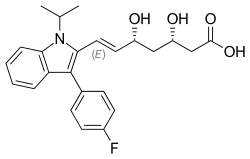
Back فلوفاستاتين Arabic فلوواستاتین AZB Fflwfastatin Welsh Fluvastatin German Fluvastatina Spanish فلوواستاتین Persian Fluvastatine French Fluvastatina Italian Fluvastatine Dutch ଫ୍ଲୁଭାଷ୍ଟାଟିନ OR
 | |
| Clinical data | |
|---|---|
| Trade names | Lescol, others |
| AHFS/Drugs.com | Monograph |
| MedlinePlus | a694010 |
| Pregnancy category |
|
| Routes of administration | By mouth (capsules, tablets) |
| ATC code | |
| Legal status | |
| Legal status | |
| Pharmacokinetic data | |
| Bioavailability | 24–30%[1][2] |
| Protein binding | >98%[2] |
| Metabolism | Hepatic: CYP2C9 (75%), CYP3A4 (20%), CYP2C8 (5%)[2][3] |
| Elimination half-life | 1–3 hours (capsule), 9 hours (XR formulations)[2][3] |
| Excretion | Faeces (95%), urine (5%)[2] |
| Identifiers | |
| |
| CAS Number | |
| PubChem CID | |
| IUPHAR/BPS | |
| DrugBank | |
| ChemSpider | |
| UNII | |
| KEGG | |
| ChEBI | |
| ChEMBL | |
| CompTox Dashboard (EPA) | |
| ECHA InfoCard | 100.224.327 |
| Chemical and physical data | |
| Formula | C24H26FNO4 |
| Molar mass | 411.473 g·mol−1 |
| 3D model (JSmol) | |
| |
| |
| (verify) | |
Fluvastatin is a member of the statin drug class, used to treat hypercholesterolemia and to prevent cardiovascular disease.
It was patented in 1982 and approved for medical use in 1994.[4] It is on the World Health Organization's List of Essential Medicines.[5]
- ^ Cite error: The named reference
ACwas invoked but never defined (see the help page). - ^ a b c d e Neuvonen PJ, Backman JT, Niemi M (2008). "Pharmacokinetic comparison of the potential over-the-counter statins simvastatin, lovastatin, fluvastatin and pravastatin". Clinical Pharmacokinetics. 47 (7): 463–74. doi:10.2165/00003088-200847070-00003. PMID 18563955. S2CID 11716425.
- ^ a b "Lescol, Lescol XR (fluvastatin) dosing, indications, interactions, adverse effects, and more". Medscape Reference. WebMD. Retrieved 18 March 2014.
- ^ Fischer J, Ganellin CR (2006). Analogue-based Drug Discovery. John Wiley & Sons. p. 472. ISBN 9783527607495.
- ^ World Health Organization (2021). World Health Organization model list of essential medicines: 22nd list (2021). Geneva: World Health Organization. hdl:10665/345533. WHO/MHP/HPS/EML/2021.02.